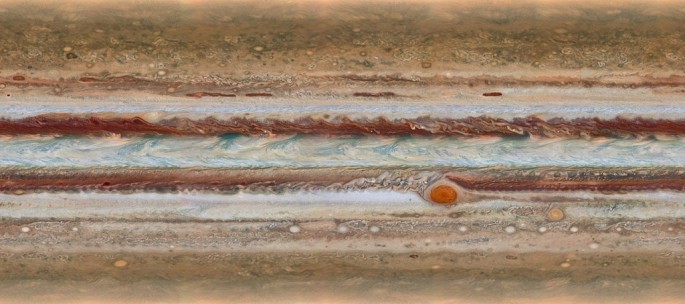Astronomers reveal a new NASA video from the largest planet in the solar system, revealing all angles of Jupiter which includes its mysterious, colossal Great Red Spot.
Apparently, observations taken from the Hubble Space Telescope now confirm that this red spot which is actually a massive swirling storm, raging on Jupiter for more than 300 years, is now continuing to shrink and even changing its red orange hue.
NASA scientists also reveal that the rate of its size decreasing has slowed down, it is now some 240 kilometers smaller compared to its size in 2014.
For the first time ever in 1979, NASA's twin Voyager probe missions conducted a flyby past the great gas giant, where measurements reveal that the Great Red Spot is about 23,300 kilometers wide.Through time, the spot gradually became smaller as the Hubble captured an image in 1995 where it measured 21,000 kilometers. In 2009, the storm was only 18,000 kilometers across.
In 2012, more observations reveal this obvious decrease in size where the rate of this shrinking spot was measured at 933 kilometers every year, changing its shape from an oval to a more circular storm. Today, the Great Red Spot is now 16,500 kilometers across where the rate slowed down, transforming the red spot into an orange one.
However, this spot is not the only significant change that the Hubble had captured. Another unique feature on Jupiter came into full view, which seems like a rare wave structure, located at the northern region of the Jovian equator.
In July 1979, a similar wave feature was also spotted but it was nearly invisible as astronomers believe that its presence was just a fluke.
Today, this new wave appears in a certain region pockmarked by massive cyclones along with anticyclones. On Earth, similar wave structures can also be seen from Earth's atmosphere when cyclones begin to form.
These new images and footage of Jupiter were taken by Hubble's Wide Field Camera 3 during a period of 10 hours, mapping the entire planet, during the Outer Planet Atmospheres Legacy (OPAL) program, which aims to capture many series of portraits of the planets in the solar system to observe atmospheric and weather conditions such as winds, storms and cloud formations.



























